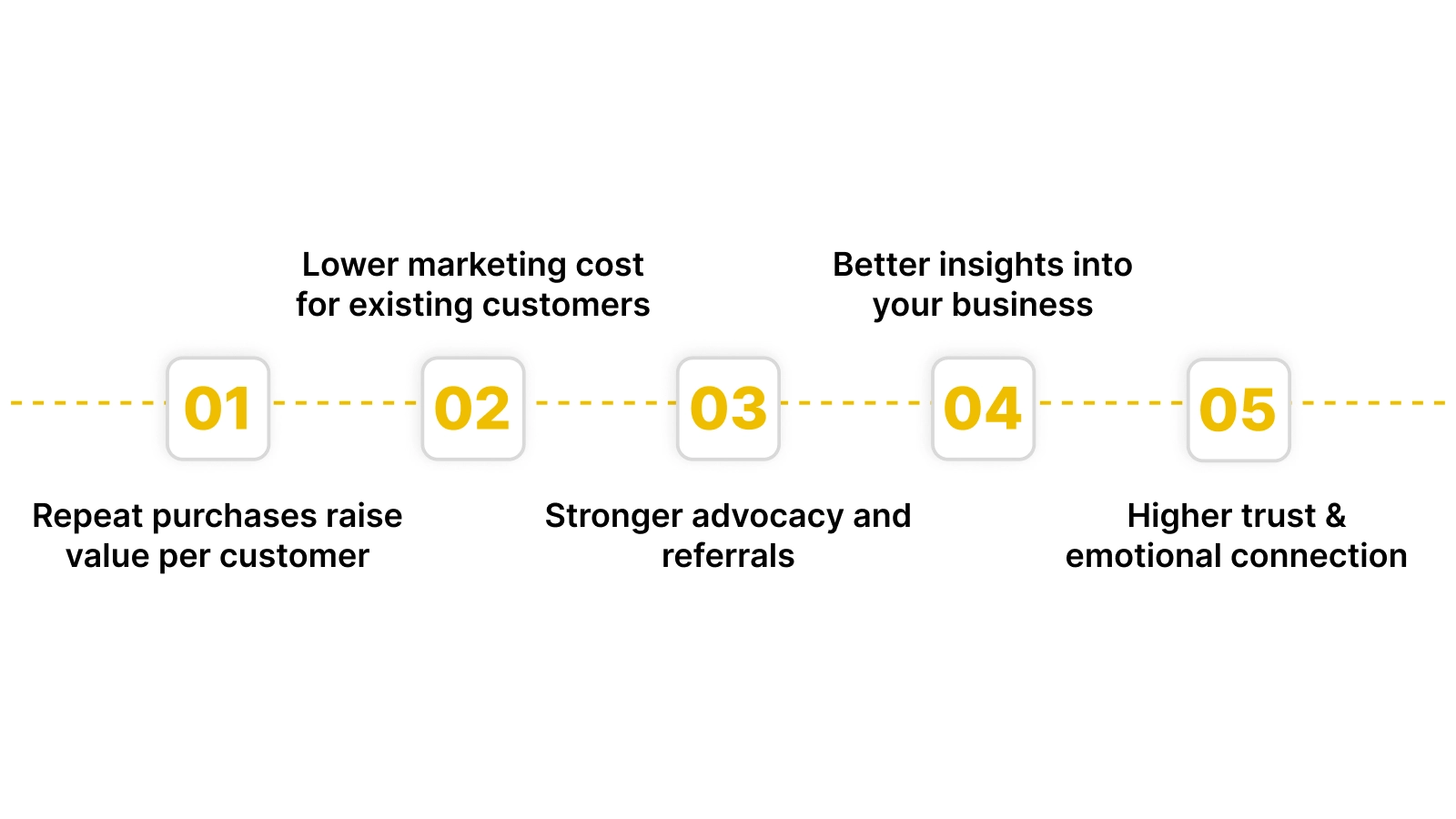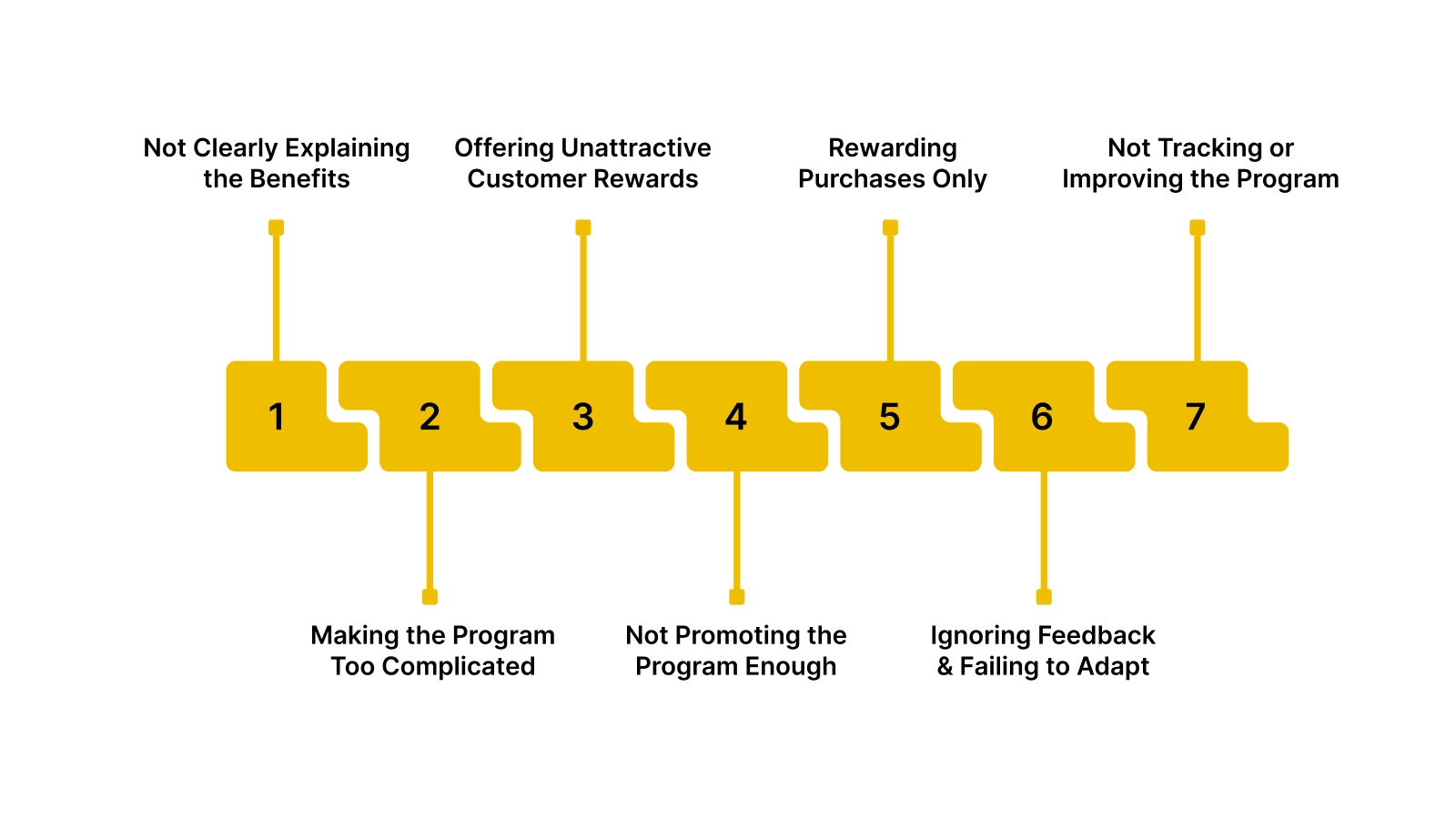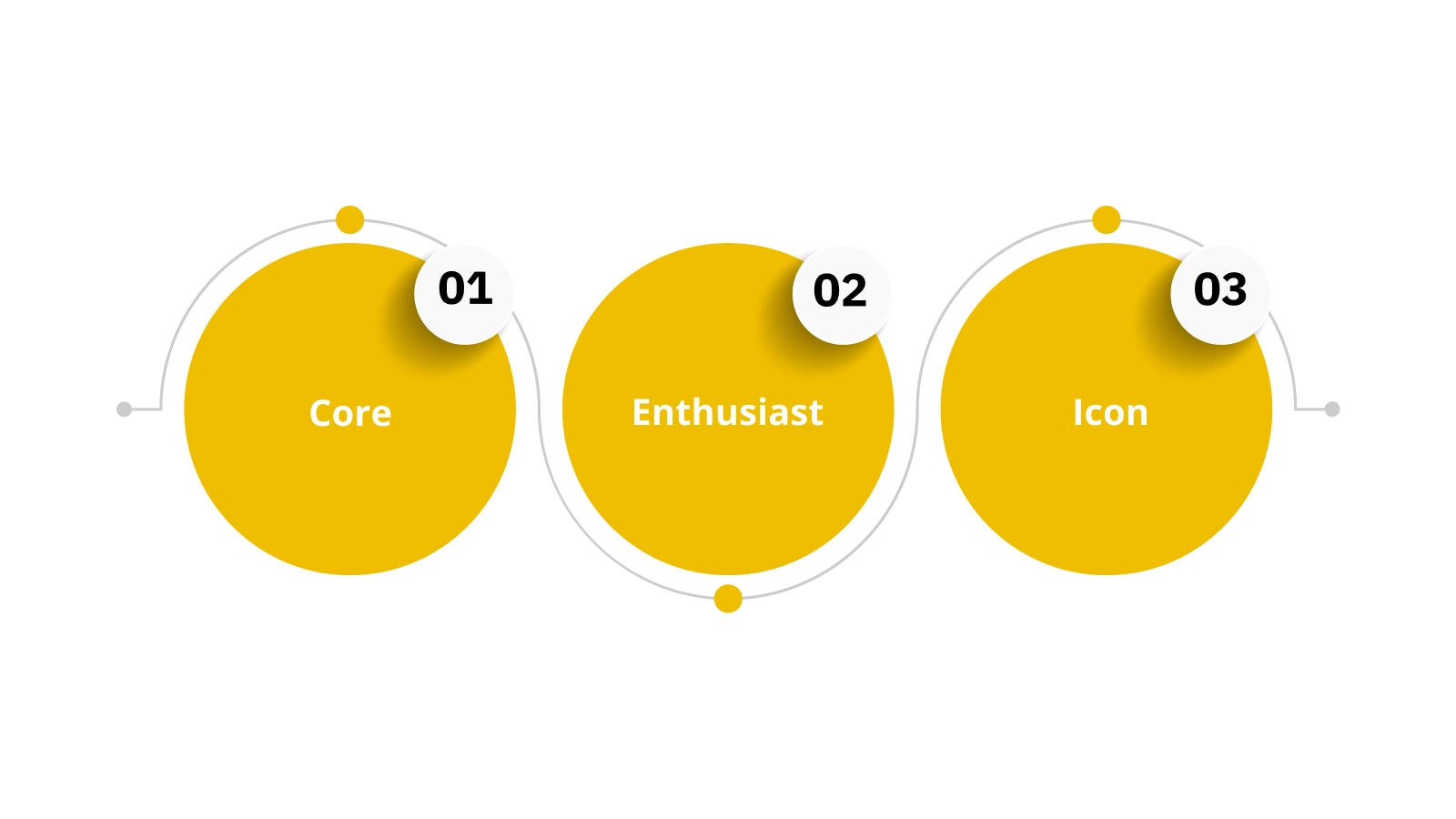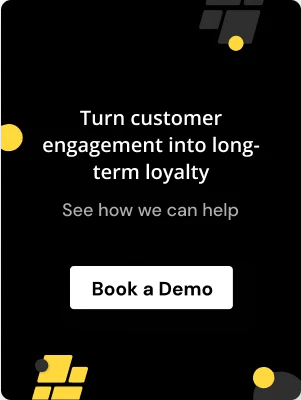.avif)
.avif)
Have you ever wondered why some brands manage to turn first-time buyers into lifelong customers, while others struggle to keep customers engaged? The secret often lies in the effectiveness of their customer loyalty programs.
In fact, businesses that invest in customer retention can increase their profits by up to 95%. Yet, many e-commerce brands unknowingly sabotage their own success by making common mistakes in their loyalty strategies.
In this blog, we’ll explore the most frequent loyalty program pitfalls you need to avoid to ensure your efforts result in higher customer retention, increased lifetime value, and better overall engagement. Let’s see how you can boost your loyalty game while staying clear of these mistakes!
Customer Loyalty: Why does it matter?

Customer loyalty is more than a nice bonus, it shapes how your business performs and grows. When your customers keep coming back, you spend less chasing new buyers and build a foundation for stronger results.
Here are five key reasons loyalty matters:
1. Repeat purchases raise value per customer
Winning a new customer can cost 5 to 25 times more than keeping an existing one.
That means focusing on those who already trust your brand gives you better returns on marketing time and money.
2. Lower marketing cost for existing customers
Because your existing customers know you, once you’ve earned their trust, you need fewer promotions and ads to get them to buy again. That frees up your budget and simplifies your approach.
3. Stronger advocacy and referrals
Customers who are loyal often tell others. For example, one study found that referred customers have a 37 % higher retention rate than non‑referred ones.
That means loyalty helps you grow through word‑of‑mouth, not just paid ads.
4. Better insights into your business
When customers return, you gather more data about what they like, when they buy and how they behave. Those patterns let you align rewards, experiences and messaging more closely with what actually works.
5. Higher trust and emotional connection
When customers feel recognized and rewarded, they’re more likely to stay. Trust reduces the chance they’ll switch to a competitor because of price or convenience.
If you ignore loyalty, you’re leaving value on the table. A well‑executed loyalty approach means you’re getting more out of the customers you already have, turning them into advocates and giving your business more stability.
Also Read: 9 Successful Loyalty Program Examples to learn from in 2025
7 Common Customer Loyalty Mistakes to Avoid

Customer loyalty isn’t just about setting up a rewards program and hoping for the best. If you’re not thoughtful about how you design and manage your program, you could end up losing customer interest rather than building long-term loyalty.
Let’s take a closer look at seven common mistakes brands often make when implementing loyalty programs and how to avoid them.
1. Not Clearly Explaining the Benefits
If your customers don’t understand how your loyalty program works or what’s in it for them, they won’t engage with it. It’s not enough to simply say, “Get rewards for shopping”, you need to show how they can earn and redeem those rewards.
Be transparent and clear in your communication. Break down the benefits in simple terms and use visuals to illustrate how the program works. Show how customers can track their progress (e.g., “Earn 100 points for every purchase, which equals a $10 discount on your next order”). The more straightforward you make it, the more likely they are to join and actively participate.
2. Making the Program Too Complicated
A common mistake is creating a loyalty program that’s too difficult to understand, with layers of rules and eligibility criteria that make customers feel overwhelmed. Complicated processes only frustrate people, leading them to abandon the program altogether.
Keep your program simple and easy to join. For example, instead of requiring customers to reach certain thresholds before they can redeem rewards, let them earn benefits with every purchase.
A simple, tiered system where customers level up after earning a certain amount of points can make it fun and easy to track their rewards. Use customer-friendly language and avoid jargon.
3. Offering Rewards That Don’t Appeal to Customers
Many brands make the mistake of offering rewards they think customers will want, rather than asking customers directly what they value. If your rewards don’t align with your customer base, they won’t feel motivated to participate.
Understand your audience’s preferences and offer rewards that resonate with them. You can gather insights through surveys, direct feedback, or by analyzing past purchase behavior.
For example, if you’re an e-commerce store selling tech gadgets, discounts on future purchases, early access to new releases, or free accessories might be more appealing than generic gift cards. Offer rewards that feel personalized and make the customer feel valued.
4. Not Promoting the Program Enough
You’ve set up a great loyalty program, but you’re not seeing the engagement you expected. Why? Because your customers probably don’t even know about it! A loyalty program that’s not regularly promoted is as good as not having one at all.
Make your loyalty program a core part of your marketing. Promote it on your website, during checkout, via email campaigns, and on social media. You can even create pop-ups or banners that highlight the program’s benefits, or offer a limited-time sign-up bonus to encourage immediate enrollment.
Don’t let your customers miss out, constantly remind them of the benefits of participating.
5. Only Rewarding Purchases, Not Other Actions
Many loyalty programs focus solely on purchases, but there are many other ways customers can engage with your brand. Limiting rewards to just transactions ignores the full potential of customer actions that can build loyalty.
Expand your reward system to include actions like referrals, leaving product reviews, social media engagement, or even signing up for newsletters. This makes the program more interactive and gives customers multiple ways to earn rewards.
For example, offer extra points for sharing your products on Instagram or for referring a friend. This encourages customers to engage more deeply with your brand.
6. Ignoring Feedback and Failing to Adapt
A loyalty program should never be static. If you don’t listen to your customers’ feedback, you risk losing touch with what they actually want. Programs that don’t evolve based on customer preferences can quickly become irrelevant.
Regularly gather feedback from your customers about the program. Use surveys or even just simple polls to ask them what they like, what they don’t, and what improvements they would suggest.
Also, keep an eye on analytics to see which rewards are the most popular and which parts of the program aren’t working. Based on that data, make adjustments to keep the program fresh, engaging, and aligned with your customers’ needs.
7. Not Tracking or Improving the Program
Without tracking key metrics, it’s impossible to know whether your loyalty program is performing well. Not measuring things like redemption rates, customer retention, or LTV means you’re running your program blind.
Set clear, measurable goals for your loyalty program and track your performance regularly. Metrics to monitor include the number of active members, redemption rate, and the average spend per customer.
Tools like Nector’s analytics can help you measure how well your program is performing and pinpoint areas that need improvement. By continuously refining your strategy, you can optimize the program for better results.
Avoiding these loyalty program mistakes can make a world of difference in retaining your best customers and turning them into long-term advocates. A clear, simple, and engaging loyalty program leads to stronger customer relationships and a more profitable business.

How Old Navy’s Navyist Program Missed the Mark

The Navyist Rewards program was designed to reward customers for shopping at multiple Gap Inc. brands, offering points for every purchase made. Members earned 1 point for every $1 spent, and those using a Gap Inc. credit card earned 5 points per $1 spent. Rewards can be redeemed at a rate of 100 points = $1.
The program is tiered, offering three levels of membership:
- Core: Customers who spend $0–$499 annually.
- Enthusiast: Customers who spend $500–$999 annually or have the Gap Inc. credit card.
- Icon: Customers who spend $1,000+ annually or accumulate 5,000 points.
Navyist Rewards aimed to offer exclusive perks like free shipping, early access to sales, and members-only discounts, with rewards that can be redeemed at any of the Gap Inc. brands.
What Went Wrong?
Despite its potential, the program faced several issues:
1. Too Many Membership Tiers
The inclusion of multiple tiers, Core, Enthusiast, and Icon, created complexity. Customers were unsure about the benefits of upgrading to a higher tier, and the varied reward structures left many feeling confused about how to earn and redeem points. This complexity likely discouraged many customers from fully engaging with the program.
2. Non-Exclusive Perks
One of the key issues with the program was that some of the so-called “member-only” perks, like discounts or early access to sales, were available to non-members as well. This reduced the perceived value of becoming a member, as customers didn't feel like they were receiving any special treatment.
3. Complexity and Lack of Clarity
Customers struggled to understand how to maximize their rewards. With multiple membership levels and different types of rewards, the program became overwhelming. Without clear communication, many customers found the program too complicated to fully engage with, leading to lower participation and retention.
Lessons Learned: What You Can Take Away
1. Simplify the Reward Structure
To avoid confusion, keep your program simple and easy to understand. If customers have a hard time figuring out how to earn or redeem rewards, they’ll disengage. A clear, straightforward reward system is essential for keeping customers involved.
2. Make Rewards Truly Exclusive
Loyalty programs should offer real value to members. If perks like discounts or early access are available to everyone, membership feels less worthwhile. Ensure that the benefits of being part of the loyalty program are exclusive and meaningful to encourage participation.
3. Communicate Clearly and Consistently
Transparency is key. Make sure your customers understand the program rules, the benefits they’ll receive, and how to take full advantage of the rewards. Changing the rules without notice can quickly frustrate members and damage trust, so keep everything clear and consistent.
Old Navy's Navyist Rewards program faced challenges due to its complexity and the dilution of exclusive perks. By simplifying the reward structure, offering meaningful benefits, and ensuring clear communication, businesses can create a loyalty program that resonates with customers and encourages long-term engagement.
Learning from these mistakes can help you design a loyalty strategy that works for both your business and your customers.

How Nector Can Improve Your Customer Loyalty Strategy
Nector makes building and managing a loyalty program easy and effective. Here’s how it helps:
- Easy Setup and Customization: With Nector, every customer can automatically become a loyalty member. You can quickly set up rewards, customize them to fit your brand, and manage everything from one simple dashboard.
- Tailored Experience for Your Brand: Create a loyalty program that matches your brand’s style. You can customize rewards, set tiers, and make the program feel unique without needing coding skills.
- Personalized Rewards for Customers: Nector lets you personalize the loyalty experience for each customer. You can reward customers based on their behavior or purchase history, making them feel more engaged with your brand.
- Track Performance and Insights: Get a full view of how your program is performing, track customer engagement, and make adjustments based on real data.
- Built-In Features Ready to Go: Nector includes all the tools you need for a successful loyalty program, like easy reward redemption at checkout, tier automation, and bonus campaigns.
Whether you’re a solo entrepreneur or growing your brand, Nector makes it easy to create and run a customer loyalty program that keeps your customers coming back.
Also read: What Is Loyalty Management? Benefits & Tips for D2C Brands in 2025
Final Thoughts
Customer loyalty is key to driving long-term success, and a well-executed loyalty program can make all the difference in retaining customers and increasing repeat purchases. By avoiding the common mistakes, you can create a loyalty strategy that truly connects with your customers. Remember, simplicity, exclusivity, and clear communication are key!
If you're ready to take your loyalty strategy to the next level, Nector offers a flexible, easy-to-use solution that helps you build and manage a personalized loyalty program with ease. With features designed to grow with your business, Nector ensures that your customers stay engaged and rewarded, driving long-term loyalty and boosting revenue.
Book a Demo with Nector Today!
Frequently Asked Questions (FAQs)
1. What are some important mistakes to avoid when building a Loyalty Program?
The most common mistakes in loyalty programs include not clearly explaining the benefits to customers, offering rewards that don't align with their interests, or creating a program that's too complex for them to engage with. Simplicity and clarity are key to keeping your customers engaged and motivated.
2. How can I make sure my Loyalty Program appeals to my customers?
To create a program that resonates with your customers, regularly seek feedback and tailor the rewards to what your audience values most. Make sure the program is simple to understand, offers rewards they actually want, and provides an experience that feels personal to them.
3. Why is tracking and improving my Loyalty Program important?
Tracking your loyalty program's performance allows you to see what's working and where you need to improve. By analyzing customer engagement, redemption rates, and feedback, you can adjust your strategy to keep the program fresh and effective, ensuring it continually drives loyalty and repeat business.
4. Can Loyalty Programs work for small e-commerce businesses?
Absolutely! Small e-commerce businesses can benefit from loyalty programs just as much as larger companies. With tools like Nector, even small teams can set up and manage a loyalty program that’s easy to use, fully customizable, and designed to increase customer retention, without needing a big staff.
5. How do I promote my Loyalty Program to my customers?
To get the word out about your loyalty program, promote it through multiple channels, email campaigns, social media, and directly at the point of sale. Make sure your customers know the benefits and how easy it is to join. Offering a sign-up bonus or incentive for the first few purchases can help get customers onboard quickly.
FAQs
Start Building Customer Retention That Lasts







.avif)
.avif)

